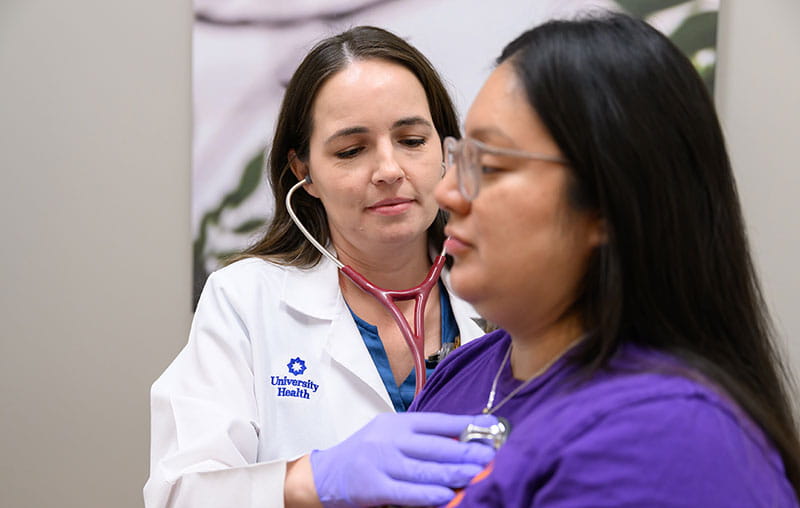When you think about visiting a doctor, sickness probably comes to mind. While it’s true that medical providers play a key role in treating acute illnesses, preventive visits are every bit as important to your health. A well-woman exam is one type of preventive health visit for women.
Dr. Denise De Los Santos is an OBGYN at University Health. She explains what to expect during a well woman exam.
What Is a Women’s Wellness Exam?
You probably know that an annual checkup is recommended to keep an eye on your overall health. That’s true for both men and women, along with children. Women, though, also need what’s known as a well-woman exam.
“Women’s wellness examinations are so much more than (about) reproductive health,” Dr. De Los Santos said. “As an OBGYN, I would like women to know that an annual exam is not just about Pap smears and contraception counseling.”
During these exams, your provider will:
- Ensure that the appropriate preventative care testing is up to date
- Ensure that age-related vaccines are up to date
- Perform a full physical including a breast exam if appropriate
Why Women Need Annual Well-Woman Exams
The American College of Obstetricians and Gynecologists recommends well-woman exams for women of all ages and stages of life. Women experience fluctuating hormones and other changes throughout their lives as they walk through puberty, menstruation, pregnancy, perimenopause and menopause.
An annual well-woman exam provides you with an opportunity to check in with an expert in women’s health. This provider can screen you for certain types of cancer, including cervical cancer and ovarian cancer, and recommend other age-appropriate screenings, including mammograms.
What’s Involved in a Well-Woman Exam
A women’s wellness visit includes two main components: the exam itself and a time to discuss concerns with your provider. This provides women with the opportunity to ask questions and talk about how they’re doing.
Physical Exam
During a well-woman exam, your provider (or a nurse) will measure your height and weight, check your blood pressure and pulse, and check your temperature. Your provider may also palpate your neck to check your thyroid and take a quick look at your skin looking for any abnormalities.
Some women see their OB/GYN as a primary care provider as well as a women’s health provider. In that case, the physical exam will be more thorough, checking your overall appearance, listening to your heart and lungs, and looking at your ears and throat.
Pelvic Exam
During a pelvic exam, your provider will look for signs of disease in the gynecologic organs and pelvis, including the vulva, vagina, uterus, ovaries, fallopian tubes and cervix. You’ll lie on your back on an exam table with your feet in stirrups, and your provider will use a special tool called a speculum to open the vagina and get a clear look inside.
A speculum examination is different from a Pap smear, though the two are related and often get confused. During a Pap smear, your provider uses a speculum to open the vagina and will use a small brush to gather cells from the cervix.
After visually examining the vagina and cervix, your provider will also exam the area manually with their hands by feeling the uterus and ovaries for any abnormalities.
Dr. De Los Santos emphasizes that patients should feel empowered to express their concerns and discomfort about the pelvic exam prior to the examination.
“As physicians we want to ensure that our patients are comfortable with the process. If there has been any history of sexual abuse or just an overall difficult examination/experience with a different doctor in the past, we can work through it together as a team,” she said.
Pap Smear
You may also have a Pap smear performed along with your pelvic exam. If you’re having a Pap smear, your provider will use a small brush to gently gather a sample of cervical cells. These cells will be examined for the human papillomavirus (HPV) and signs of cervical cancer.
The U.S. Preventive Services Task Force recommends a Pap smear at least every three years for women ages 21 to 29. Beginning at age 30, women can choose to continue having Pap smears every three years, or they can choose to have an HPV test every five years or co-testing using an HPV test and a Pap smear every five years.
“Even though cervical cancer screening intervals have increased, the recommendation for women’s wellness examinations has not changed and continues to be yearly,” Dr. De Los Santos noted.
Breast Exam
During this portion of the exam, your provider will check your breast tissue and under your arms for any lumps or other abnormalities. This involves gently using his or her fingertips to press down into the breast tissue. You may be asked to raise your arms above your head to allow for a thorough exam.
Schedule Your Well-Woman Exam at University Health
Staying up to date on annual wellness exams is the best way to stay healthy and prevent health problems before they start. Schedule an appointment with a University Health women’s health provider today.




